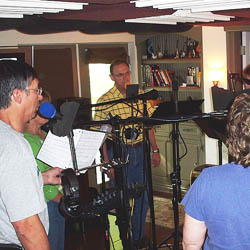It seems an impossible task. You want to record several unaccompanied singers with very good isolation between them (low leakage). But you can’t use isolation booths.
The singers need to see each other for visual cues and hear each other easily. The goal is to record them all at once in the same room, yet isolate the sound of each singer—without any audio problems.
Recording engineer Jack Gregory and I faced that challenge when recording the talented A Cappella Christian-music group Joyful Noise.
The usual way to record a small choir is with a stereo mic pair (or stereo microphone) in a reverberant church or hall.
But the group wanted to edit each singer’s performance to adjust timing and pitch. That’s not possible when the entire group is recorded on two tracks.
Isolation booths: Not the best solution
First, Jack tried placing each singer in an isolation booth, wearing headphones to hear each other. Although each singer had a headphone mixer, they had a hard time setting up a cue mix.
They were wasting time working on technical issues rather than musical ones.
Also, they could not see each other for timing cues, making it hard to perform well. Since the tempo of the music is fluid, a click track would not work.
Miking for isolation
Our goal was to put all the singers together so they could see and hear each other acoustically, without headphones. The mic technique shown below worked great.
We used six Shure SM58 microphones aiming apart in a circle. Each mic had a foam pop filter.
Adjacent mics were three feet apart, and each singer sang with lips touching their pop filter, as if they were using a handheld mic.
Each mic was angled up about 45 degrees to pick up nose sounds as well as mouth sounds. Otherwise you’d hear a “nasal” or “closed-nose” effect.
Soloing each mic, we heard very little of the other singers. Isolation was excellent. Play the audio sample below to hear one mic soloed with everyone singing.
Three factors contributed to the success of this method:
1. Close miking—following the 3:1 rule to prevent phase interference between microphones.
2. Using cardioid mics angled apart.
3. Using proximity effect as noise cancellation.





















